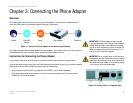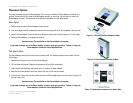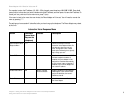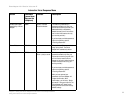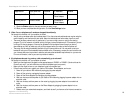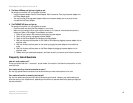
13
Appendix A: Troubleshooting
Common Problems and Solutions
Phone Adapter with 2 Ports for Voice-over-IP
Appendix A: Troubleshooting
This appendix provides solutions to problems that may occur during the installation and operation of the Phone
Adapter. Read the description below to solve your problems. If you can't find an answer here, check the website
of your Internet phone service provider or the Linksys website at www.linksys.com.
Common Problems and Solutions
1. I don’t hear a dial tone, and the PHONE1 (or PHONE2) LED is not lit.
Go through this checklist until your problem is solved:
• Make sure the telephone is plugged into the appropriate port, PHONE 1 or PHONE 2. (You should use the
Phone 2 port only if you have more than one Internet telephone service account.)
• Make sure the ETHERNET LED on the front panel of the Phone Adapter is lit. If it is not lit, then check your
router and network connection to the Internet.
• Pick up the telephone. Press 80#. Hang up the telephone. Wait approximately 30 seconds. Then pick up
the telephone; you should now have a dial tone.
• Follow these instructions to reboot your cable or DSL modem, Phone Adapter, and router:
1. Power off your cable or DSL modem by unplugging its power adapter.
2. Power off the router by unplugging its power adapter.
3. Power off the Phone Adapter by unplugging its power adapter.
4. Wait two minutes, and then power on your cable or DSL modem by plugging its power adapter into an
electrical outlet.
5. Wait two minutes, and then power on the router by plugging its power adapter into an electrical
outlet.
6. Wait five minutes, and then power on the Phone Adapter by plugging its power adapter into an
electrical outlet.
7. Reboot one of your networked computers, and check to see if you have an active Internet connection.
8. Pick up the telephone. You should now have a dial tone.
• Set up port forwarding on your router. You must specify that four port ranges be forwarded to the IP
address of the Phone Adapter. These four port ranges are as follows: 5060-5061 (UDP), 53-53 (UDP),
69-69 (UDP), and 10000-20000 (UDP).
Before you set up port forwarding on your router, change two of the Phone Adapter’s settings using its
Interactive Voice Response Menu. First, disable its DHCP feature, and then assign a static IP address to
the Phone Adapter. Refer to “Chapter 4: Using the Phone Adapter’s Interactive Voice Response Menu” for
instructions.



